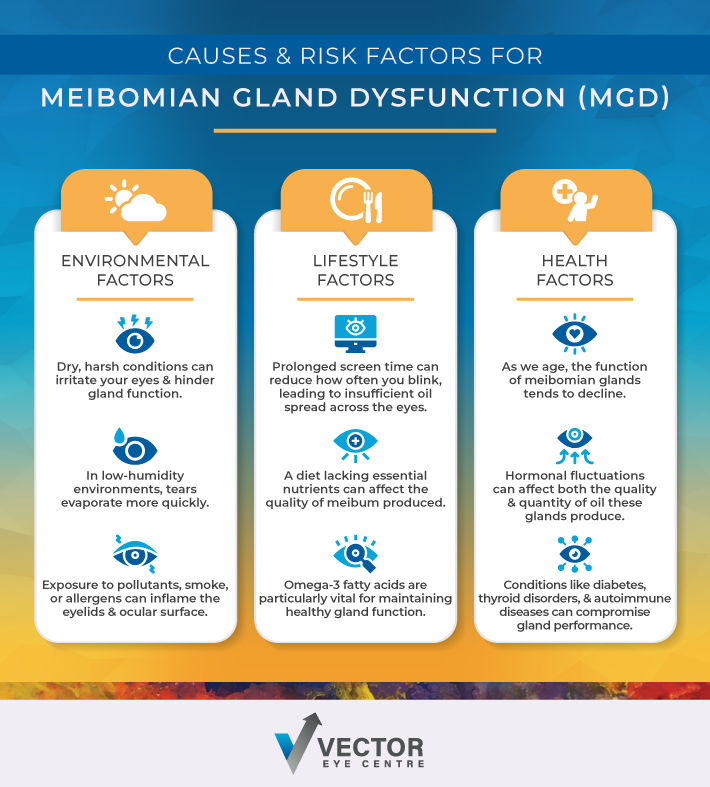Meibomian gland dysfunction (MGD) is a common yet often overlooked condition that can significantly impact eye health.
This dysfunction occurs when the meibomian glands, which produce the lipid component of tears, become obstructed or impaired in function. As a result, individuals may experience dry eyes, irritation, inflammation, and even difficulty wearing contact lenses.
MGD can be attributed to various factors, including environmental influences like low humidity and pollution, lifestyle habits such as excessive screen time and poor dietary choices, and health-related issues like aging, hormonal changes, and chronic diseases.
The repercussions of MGD extend beyond mere discomfort, potentially leading to more severe complications such as ocular surface damage and discomfort that can affect your quality of life. Understanding the various factors that contribute to this condition is essential for effective management and prevention.
What Are Meibomian Glands?
Meibomian glands are small, oil-producing glands located in the eyelids. There are around 30 to 40 meibomian glands in the upper eyelid and 20 to 30 in the lower eyelid.
When these glands function correctly, they contribute to healthy, well-lubricated eyes. However, when they become blocked or their function diminishes, it can lead to MGD. This dysfunction disrupts the tear film, often resulting in symptoms such as dryness, irritation, and blurred vision.
The Connection Between MGD & Dry Eye
MGD occurs when the tiny oil glands along the eyelid margins fail to secrete enough oil into the tears, which is why it is one of the primary culprits behind dry eye. This oil is crucial for tear production, creating a protective layer that slows tear evaporation. Addressing MGD can help manage dry eye effectively, as treating the underlying dysfunction can restore the lipid layer and improve tear stability.
Common Causes of MGD
Several factors can lead to MGD, from environmental influences to underlying health conditions.
Environmental Factors
The environment plays a significant role in eye health. Harsh conditions can irritate the eyes and impact gland function.
- Humidity levels: Low humidity can accelerate tear evaporation, putting extra strain on the meibomian glands. Environments with consistently low moisture content, such as air-conditioned or heated spaces, can exacerbate dryness.
- Pollution and allergens: Exposure to pollutants, smoke, or allergens can lead to inflammation of the eyelids and ocular surface. Irritants in the air can obstruct gland openings, preventing proper oil secretion.
Lifestyle Factors
Day-to-day habits greatly influence your eyes and meibomian glands.
- Screen time: Prolonged screen exposure can reduce blinking frequency, leading to dry eyes and inadequate oil distribution. This can create a cycle of irritation and gland dysfunction.
- Dietary choices: A diet low in essential fatty acids and nutrients can negatively impact meibum quality. Omega-3 fatty acids, in particular, are important in maintaining gland function and overall eye health.
Health Factors
Underlying medical conditions can also lead to the development of MGD.
- Age: As individuals age, the function of meibomian glands tends to decline, often correlating with an increase in symptoms and severity of MGD.
- Hormonal changes: Fluctuations in hormone levels, particularly during menopause, can alter the quality and quantity of oil the glands produce.
- Chronic diseases: Conditions such as diabetes, thyroid disorders, and autoimmune diseases can impact the meibomian glands, either directly or through associated inflammation.
How to Identify MGD
When you know the signs of MGD, you can take action to minimize your symptoms and reduce the risk of long-term effects.
- Persistent dry eye
- Redness
- A gritty feeling as if something is in the eye
- Blurry vision
- Sensitivity to light
Another hallmark sign of MGD is fluctuating vision, where clarity varies throughout the day. This can be particularly noticeable during tasks requiring sustained visual focus, like reading or driving. Additionally, you may notice crusting along the eyelid margins or eyelid swelling and tenderness.

Diagnosis & Treatment Options for MGD
Diagnosing MGD typically involves a comprehensive eye examination. Eye doctors may perform tests to evaluate meibomian gland health (truncation, atrophy, degeneration, shortening, loss) and tear breakup time, measure tear production, and assess the health of the eyelid margins. These tests help confirm MGD and exclude other potential causes of symptoms.
Once diagnosed, several treatment options are available. Thermal lid treatments, such as LipiFlow, Intense Pulsed Light, and Radiofrequency, use heat and pressure to unclog the glands and restore normal function. Eye drops, including lubricating and anti-inflammatory varieties, can provide relief and support healing.
Can MGD Be Reversed?
While complete reversal may not be feasible for everyone, many patients can significantly improve their symptoms and gland function through a combination of medical treatments and lifestyle modifications.
Regular eyelid hygiene, warm compresses, and omega-3 supplements can complement medical interventions. This multifaceted approach can address both symptoms and underlying causes.
Explore Long-Term Treatments for MGD
Regular eye exams help detect MGD and other eye health issues before they progress. These checkups provide an opportunity to discuss concerns, receive personalized recommendations, and promote better eye health.
If you’re interested in learning more about treatments for MGD, contact the Vector Eye Centre team. We can help you explore your options for treating chronic dry eye and MGD and set you on a path to relief.



